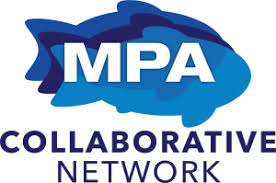Marine Protected Areas (MPAs) Collaborative Network
The MPA Collaborative Network works to encourage civic engagement in local resource management to ensure the health and sustainability of our natural and social environments to empower coastal communities to advance MPA management and encourage ocean stewardship.
There are fourteen collaboratives along the coast working to carry out projects that answer local needs for MPAs. This is a bottom-up localized, and participatory approach to resource management. Rather than the state providing a structure for engagement, collaborative members develop it themselves. This leads to more buy-in and resource sharing from local organizations and allows state agencies to respond for requests for structure and input, rather than feeding it from the top-down.
EAC is a proud member of the Golden Gate Collaborative Network
EAC Team member Leslie Adler-Ivanbrook is a current co-chair along
with David McGuire, Shark Stewards, and Paul Hobi, Seabird Protection Network
Golden Gate MPA Collaborative Projects and Partnerships
The Golden Gate MPA Collaborative has successfully brought together environmental NGOs, agencies, fishermen, scientists, aquaria and vessel captains interested in raising awareness of marine protected areas in Marin and San Francisco counties, including the Farallon Islands.
Learn More about the Golden Gate MPA Collaborative
Partners:
Aquarium of the Bay, California Academy of Sciences, California Department of Fish and Wildlife, California Coastal Commission, Greater Farallones National Marine Sanctuary Association, Greater Farallones National Marine Sanctuary, Golden Gate Audubon Society, Marin County Parks, Marin County Sheriffs, Marine Mammal Center, National Park Service, Natural Resources Defense Council, Office of Assemblyman Marc Levine, Point Blue, Point Reyes National Seashore Association, Pillar Point Harbor, Romberg Tiburon Center for Environmental Studies, Seabird Protection Network, Shark Stewards, Sierra Club SF Bay Chapter, U.S. Fish and Wildlife Service, Watershed Alliance of Marin, and Environmental Action Committee of West Marin.
education
Are you an ocean ambassador?
Take this online training to test your skills on California’s network of MPAs.
In the spring of 2019, the Ocean Protection Council hosted a California MPA Workshop called, Safeguarding Our Underwater Wilderness: A Deep Dive into California’s Marine Protected Areas.
Presentations (video) by California Department of Fish and Wildlife, Dr. Pete Raimondi UC Santa Cruz, and Dr. Jenn Caselle UC Santa Barbara.
get involved
Are you a coastal and ocean stakeholder living in the Bay Area?
Join the MPA Collaborative Network and get involved with your local stakeholders at the Golden Gate MPA Collaborative. Contact Morgan directly below to join our team!
leslie[at]eacmarin.org
Golden Gate MPA Collaborative
mini ROV Explorations of marin’s mpas
Check out the August 2019 Golden Gate MPA Collaborative exploration of Duxbury Reef State Marine Reserve and journal entry by EAC’s intern, Ashley Wemp.
Tide pools at Agate Beach, Bolinas, California
August 2, 2019
By: Ashley Wemp, EAC MPA Watch Summer Intern
Waking up at dawn to head to Duxbury Reef in Bolinas, California to check out the tide pools with the Trident was exciting. There was a beautiful sunrise and the weather was perfect. A seal even came to check us out!
The goal of this trip was to test out the ROV in tide pools to see if we could use it during school groups to give students an underwater view of the pools. The walk out to the pools was a bit challenging due to the slippery seaweed, but we made it. When we deployed the Trident into the first pool we realized that we had forgotten the weights that attach to the ROV! The current was strong in this area so it was able to move the ROV back and forth. Since the ROV couldn’t dive, we placed it on the surface in a couple more pools to see what species we could see. There was mainly algae, snails and hermit crabs in these pools. We also tried leaving the ROV in a pool and walking away to see if any cryptic animals would emerge but to no avail.
After a couple hours of hanging out on the reef, we were ready to go, but decided to try one more pool. We saved the best for last! We saw a sea star, anemone, and an opalescent nudibranch! The next trip we will remember to bring the weights to get an even better look into the underwater world!
Once back at the office, the footage was uploaded to iCloud and we were able to view the high-quality video. The footage was then uploaded to iMovie to create a short video that can be used for educational purposes. We look forward to the next opportunity to use the Trident to bring students closer to the underwater world!








